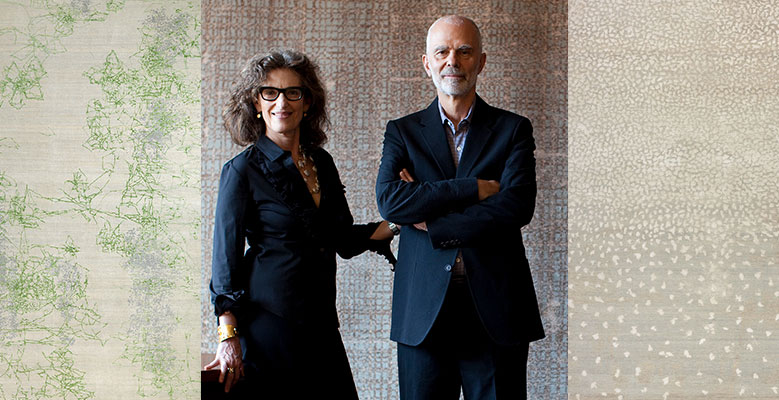Suzy: This is Suzy Annetta from Design Anthology magazine. I’m sitting here this afternoon with Brad Davis, who is one half of Fort Street Studio. So Brad, your partner in life and in work, Janis Provisor, couldn’t be here with us unfortunately. The two of you were recognized as accomplished artists and were sustaining a living of your art careers before you started the company. So do you want to start the conversation about how you started the company in China?
Brad: Let’s go back a little bit further to why we went to China at first place. I had been interested in Chinese painting for many years. I had collected Chinese paintings, and curated an exhibition of it. We were coming to HK regularly for the auctions; we borrowed works from Hong Kong collectors and Chinese University collections for this exhibition. I always wanted to go to China, but at that time it wasn’t possible to freely travel in China.
Suzy: What year we are talking about roughly here?
Brad: We are talking about 1981-82, first trip to HK was 1981. Janis was invited to make traditional Chinese woodblock prints like Crown Point Press in San Francisco in 1989. So, we came to China. It was a very exciting time. We really fell in love with Hangzhou, and we wanted to come back and live there.
Everybody in our group thought we were crazy, why would we come back, because we had significant art careers. We were showing in the United States and Europe. We were in major museum collections in New York City, throughout the States, and Europe. But in 1993, the art world sort of closed-up shop because of the recession in the United States. We were all doing really well, making a good living. We built a house in Colorado, where we lived part-time. So, we thought, rather than stay in New York, and be depressed about the state affair in the art world, this was our window of opportunity to have an adventure and go to China for a year.
We set up a woodblock studio during that time in Hangzhou to make prints of our work. Also, I thought – Hangzhou is a center of silk industry – why not make a silk carpet for our loft in New York? It could be a great idea. So, through a friend, I had lunch with a retired manager of silk carpet company. We talked about silk carpets and talked about the problems of silk carpets – they were really low pile, they were really shiny, that this is NOT what we were after.
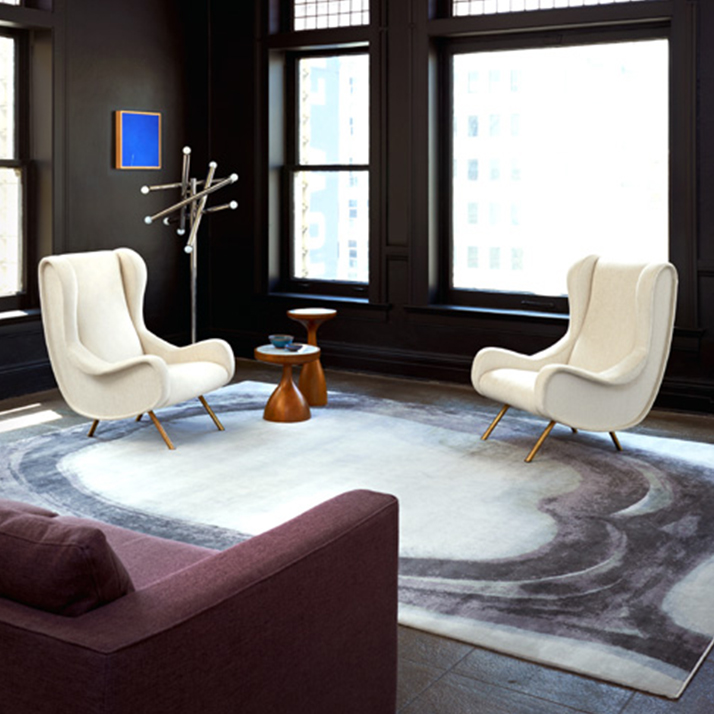
Earlier we had a Chinese art deco carpet from the twenties, from Tianjin. We loved it. In the design, there were huge flowers about 16 inches in diameter, that had a kind of bleed from one color to another. I thought, if you could do that in a little detail of the flower, why can’t you make the whole carpet? That was the first real intuition about how we could make a carpet that looked like a watercolor. Both Janis’s and my work used a kind of blending effect in our paint handling, and we wanted to make a carpet to look like that. That had never been done before.
So I talked to Mrs Lu, the retired carpet manager. She said, “it may be possible, the patterns don’t really go that way, I am not so sure…” I said “Why not? We will try for a week or so to make some designs, and then you come visit us to see what you think.” So, Janis and I hunkered down to work. Actually, we worked 10 days straight without leaving our apartment. We did 40 designs in our little bedroom which was the only studio we had. We pinned them up all around the wall. Mrs Lu came to see the new designs. Then she put her hands on her forehead and said “ Meiyou, meiyou, meiyou”, which means a lot of things in Chinese, basically – “no way, not going to happen, you can’t do that, it’s inconvenient. So I said, “What about this, what about that, what if you break it down this way. So she said well, MAYBE,” but she really didn’t think it was possible.
I took our drawings and the photographs to Hong Kong. I went to the Art History department of Hong Kong University, where my friend taught, and used their Xerox machine to break down one of the patterns into tiny little parts that would look like knot. Serendipitously, next door there was a guy who was digitalizing their entire slide library. He said, “Why not try Photoshop, to break it down into pixels? With that, I said, “One pixel, one knot.” And that was the real inspiration about how to do this. A light bulb moment!
That was where we began. I drew a little pattern based on the Xerox to show this small weaving studio what I wanted, and he began to weave it. But we had leave, so there wasn’t time to complete it. We moved back to HK, because I really thought we could make this work, and the art world have not picked up, so we weren’t missing anything. I spent the time in HK teaching Art History at Chinese University, and spent my nights and weekends working with graphic designer to learn Photoshop and to learn how to do transformation of watercolors into patterns. The designer thought, maybe we’ll work on it for two months. Well, it took 6 months. It was much more difficult than either one of us understood.
The main problem was that the scan of the watercolor had thousands of colors, which need to be broken down in Photoshop to a smaller number. Then,we had to get it down to weavable number of colors, which at the time between 12 and 24 colors. That was the goal, and that was the problem. How to break down this really complex pattern into a weavable number of colors that weavers could work with and still retain that effect of a watercolor.
The next biggest problem was dyeing. Traditionally, Chinese carpets had bold colors and simple color relationships, and we were asking the dyer to dye 5 steps of one color from light to dark. Then 5 steps of another color. Then 5 steps of another color. So, this became our next biggest challenge. When we got the pattern, we were able to put it in a pattern grid. We could make a weavable and readable pattern, but the dyeing was a huge problem.
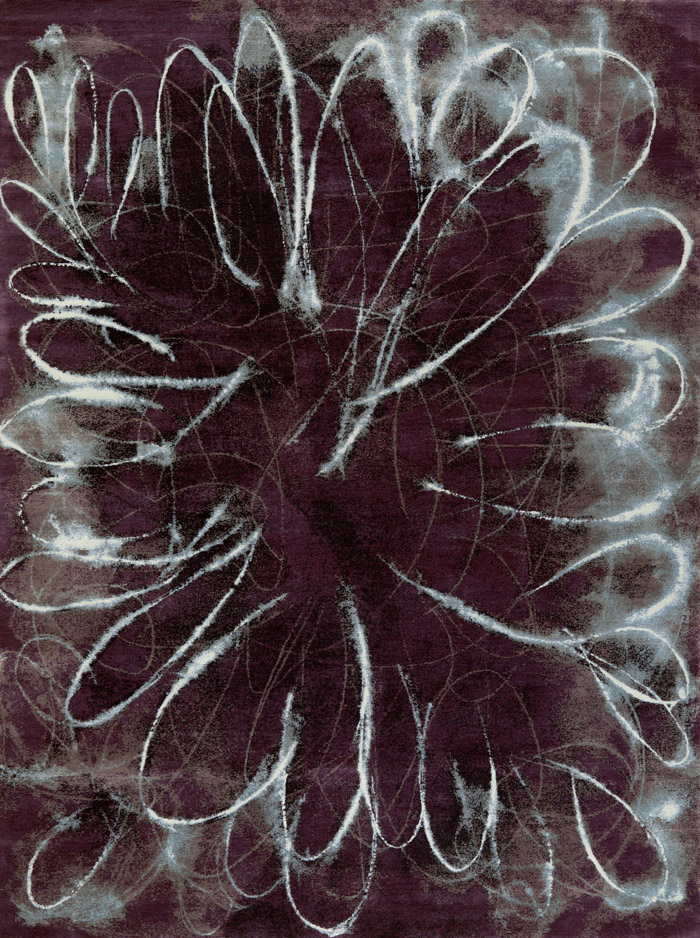
Suzy: So how long did that take?
Brad: The first sample after we got the pattern, well, that is an interesting story. Because none of the weavers at the factory had ever worked on our patterns, the workshop owner had to weave it himself. Nobody else would touch it, because they thought it was just too bizarre, too challenging. They didn’t know what to do with it. But he was attempting to get our business, and thought that this would be a way to do it, because the carpet industry already at that time had started to wane. He was looking for business, so, he was willing to bend over backwards to do this crazy New York artist’s project that he thought may or may not go anywhere. He diligently, knot by knot, wove this pattern.
Suzy: And how long did that take?
Brad: Well, it was a small pattern, it was 2 feet by 3 feet. It was a bathmat size, basically.
Suzy: So really it was just a sample?
Brad: It was just an oversized sample. And I think it took him about 2 and a half months to weave it.
Suzy: With the whole sets of challenges, the two of you clearly persisted. What was it that kept you thinking you could do it for yourself, but also that they were sort of sustainable business?
Brad: I often look back on that, wonder why did we did do this. It’s a very good question. I think the answer that I always fall back on, is that artists are problem solvers. They see a problem, and they just dig in and try to solve it. And I think that kind of tenacity and curiosity – trying to achieve something that never been done before – is kind of like climbing a mountain. We thought, if we can really do this, we really had something
Suzy: I would say this description suits a designer. I wouldn’t have necessarily thought it would apply to an artist. So, do you think that somewhere along the line you crossed over?
Brad: Well, that is also an interesting question, and I think there are several aspects to that answer. One, when Janis and I got together, we built a house together in Colorado. We had such a great time and so much fun, that when the house was finished, we were really upset because we couldn’t go to lumber yards, we couldn’t go to plumbing supply shops, we couldn’t look at lighting, we couldn’t look at flooring, we couldn’t choose paint colors, anymore. We loved the process so much. We loved working together, because we were both stubborn personalities, but we found we really had a chemistry working together, and really enjoyed it. The tussle back and forth, coming up with the solution that we both agreed on was an interesting challenge.
That was the background for us both to take it on as a challenge. We also found design really interesting and fascinating, and that goes back to my earlier work. Because I was involved with the artistic movement called Pattern and Decoration. Pattern and Decoration was a group of feisty, irreverent artists who wanted to challenge this sort of minimalist, conceptual mafia that existed at the time.
We drew inspiration from all different sources, particularly from South Asia and Middle Eastern and East Asian design and painting. A lot of that work is decorative, so it bridges the gap between art and design. We didn’t see a clear distinction between decoration, design, and art. We felt they were in harmony. So, it wasn’t a big leap for us to say, well, why not make a carpet? Because I’ve made wallpaper, I had decorated my borders of my paintings with fabrics, had worked on big installations that were like room decoration. It seemed perfectly natural and an extension of my thinking. And Janis, too, had a feeling that there really wasn’t much difference between making art and design. She had made jewelry. The difference is that that you probably put more of your personality into art, than you do into design. But we didn’t see a vast separation of these two.
Suzy: It was a lot of blurring the edges that happening.
Brad: I think that was the important step, because art had become so austere and separate from life. The art world was so estranged from design, so estranged from architecture, and so estranged from living with art. I mean, a lot of it denied the object, it was an idea, it was ephemeral, it only existed as a set of strategies. That kind of thing. So, that is why we were inclined to do something as crazy as this carpet project.
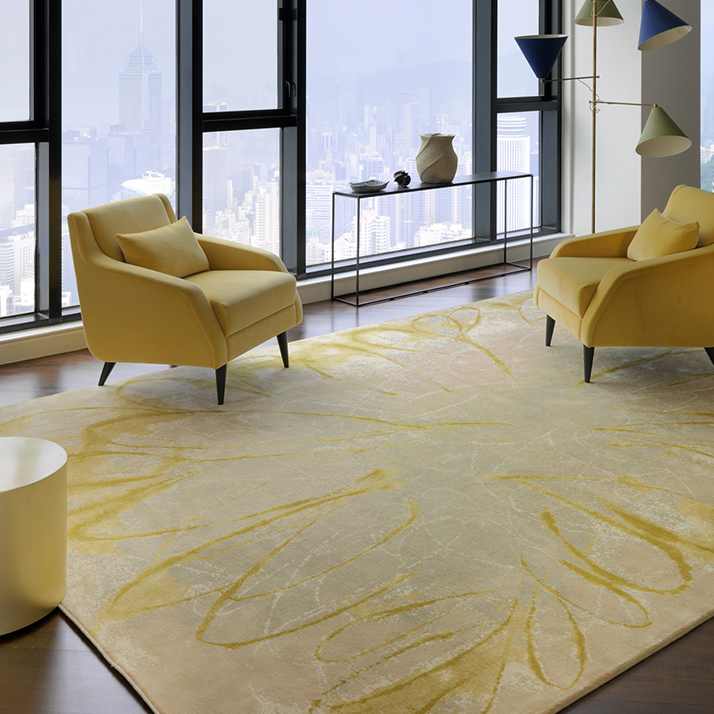
Suzy: So, if we go back to the start with the very first challenges that you faced, which was translating your artwork into something digital, that could then be given to the weavers. Is it fair to say that those challenges were probably unique to the time, because the software and the hardware that were available then was obviously very different from what is available now?
Brad: Well, there was no dedicated software available. There was something for textile design which would make repeats automatically, that you could break things down into individual colors. Fabric design had used digital software to create new designs. The carpet industry was an ancient industry, it was strictly hands-on, handmade, and everything done in the old way. So, there was no motivation within carpet industry to change. And the carpet industry was really in the doldrums at that moment, because they had traditional designs which came from Middle East cultures and Indian cultures, that had been circulating for hundreds of years, and still being made in slightly inferior, brighter colors, but hadn’t changed for millennium. The only real innovation in carpet design happened during Art Deco period, all of a sudden carpets became geometric, they became symmetrical , they used new color combinations, but they didn’t change the technology of carpet making. They just changed the design. It was all done the same way.
Suzy: When you launched these carpets, it was really groundbreaking, no one has ever done this before, particularly that painterly style, the watercolor style, which of course now is almost common place. Of course, that process has certainly, would you agree, become easier mostly because of the technology?
Brad: We were the pathfinders and ground-breakers figuring out how to do this. Carpet industry took note of it, once it was popular and people were buying it. We were very lucky. I took that 2 by 3 sample around New York and showed it to some design editors, and they were very curious about it. I showed it to some architect friends, and they thought they had never seen things like it. “Maybe I can use it.” I showed it to a couple of carpet showrooms. It turned out that I walked into the office of Rick Zolt, who was the procurement manager of Stark Carpet, which was the biggest carpet company in the United States. They had about 20 showrooms around the country, and Rick was responsible for bringing in new material. He looked at the sample, and said that somebody asked me for something like that recently. “I think this might work!” Just like that, without any discussion he said, “When can we have some, I’ll give you a show.” So, Design Week at the D&D building in New York City was our debut in the United States. We went to the top. With such speed. In one leap. Such damn luck! That event began to establish us with the design community of New York, which is probably the most powerful, largest and most significant in the world.
Suzy: And that style has been copied, it’s almost got easier to copy now, as well as things.
Brad: Carpet industry has caught up, there is now software of various kinds, in various countries, like Nepal, India and New York, too. There is design software specifically for carpet design, and specifically for transforming kind of amorphous watercolor-like designs into a weavable pattern. I might add, that they are not quite as good as what we do, because they average things out a little too quickly. They don’t maintain the subtlety of color, and they don’t usually use as many colors. But they jump-started this carpet vocabulary in markets around the world. They are everywhere now, and everybody is aware. There are many styles of carpets to choose from.
Suzy: So, while the design has sort of becoming easier, the actual physical production has become difficult because of skills in dying and weaving, the younger generation everywhere does not necessarily want to learn this kind of things. Do you want to talk a little bit about some of the challenges you are facing particularly in China?
Brad: Well, in China, I have to go back to the very beginning, to say that we came in at exactly right moment. The carpet industry was not flourishing, factories were desperate to find ways to continue production. They had been making carpets, in the past, for a mythic market that didn’t exist. For the most part, Chinese people, at that time, weren’t using carpets at all in their homes. And the designs were based on old Chinese motifs in bright strong colors that were not acceptable to the Western market.
I remember when I was living in New York, there would be this huge exhibitions, sort of what we now call “Pop-ups,” where Chinese carpets companies filled in enormous spaces with hundreds, or even thousands, of carpets. They were selling them for nothing. A few hundred US dollars. When I got to see what went into making a carpet, how much time and money goes into it, they were just giving them away. They were selling for fraction of what they cost to produce in China at that time, when the economy was very different from what is now. They were desperate to find their market. So, anybody that had an idea that came to them, they were willing to work with them.
And here came these two artists who didn’t know anything about carpets and had a hair-brained idea. They were willing to work with us. I might add, a serendipitous kind of element happened. The domestic silk market had become very overheated because the Chinese textile industry has flooded the European, and, particularly, the American market with silk garments. It was very popular. So, the cost of silk skyrocketed in China because of this demand and this overproduction. The obviously struggling carpet makers couldn’t afford this silk, anymore. At that time, as well, the PLA, the Chinese army, decided to stop using wild silk. It had been used for its strength and cost at that time. It was used for parachutes, for gun belts, for webbing to pick up munitions. All these kinds of military uses. The army realized, I think, there was a limited quantity because it was wild, and they couldn’t increase the production. So, they were moved for to synthetics, like nylon and such.
So all of a sudden, all this wild silk came onto the market, and nobody had much knowledge of how to use it. They had used it for rough fabrics for lampshades. Carpet people in the silk carpet industry set out to experiment with it. It was difficult to degum. ( the gum is what the moth uses to form a cocoon.) It was difficult to dye because it was less penetrable than domestic silk. It was very strong and hard to reel because it was slightly bumpy and irregular. You couldn’t just spin it easily. There were a lot of technical problems that the carpet industry had to solve. We chose to use wild silk for our designs because we wanted a thicker pile, a very plush pile, and we also wanted a suede finish, not a shiny finish. We all struggled together to come up with the right pile height, right degumming, right dyeing for this new product.
It all came together.
If any of the elements had been different or opposite. The price of wild silk being too high, and there being no alternative, we probably would have given up. If the technical problems had been overwhelming, we probably would have given it up using this new silk. But we all persevered because we wanted it to work.
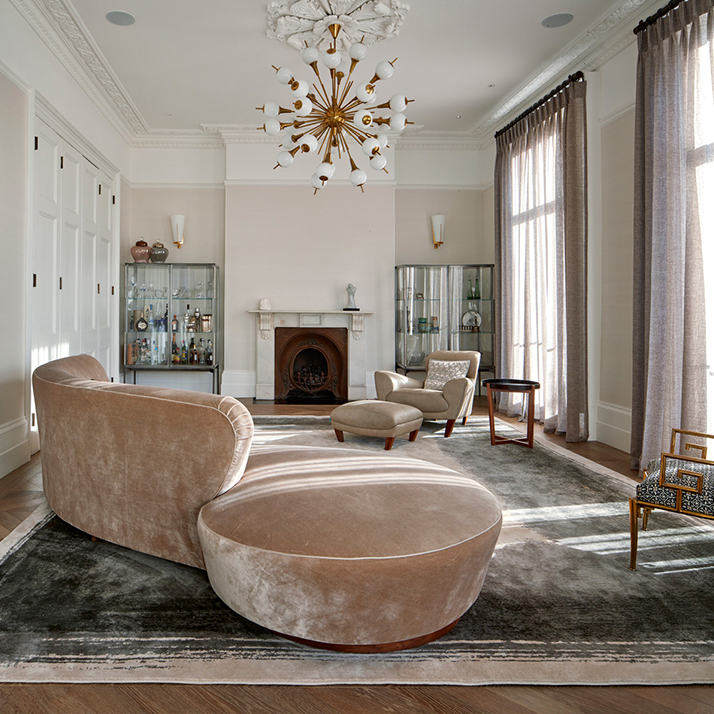
Suzy: And the market conditions were right but now things are changing.
Brad: Yes, China is changing because new status of employment. When we started this in the early 90s, being a highly skilled weaver with lifelong skill was a high status job. Now it is considered low status job. So, people aren’t going into it. They would rather get college education and work in some white collar job for an international company. Manufacturers in China are having a hard time recruiting skilled labor because of this change in the economy and the change of perception of work. So many industries in China are at a loss to replacing their retiring workers. For silk and wool carpets, all kinds of embroidery, all these traditional Chinese crafts are disappearing, because nobody wants to do it.
Suzy: Which is ironic, I think, because it’s almost right on the cusp of time and history where “Made in China,” and what that means to people outside of China, is changing. And the fact that those heritage skills, crafts and techniques may disappear right at this very time.
Brad: Right at the moment. But this is how things go. It’s not just China. I mean these kinds of skills have disappeared around the world. In America, at one time there was a lot of craftsmanship, for furniture making, for all sorts of design and handmade things. These things weren’t made in European any more. Europe had lost most of its crafts people. There are still a very few economies, like Nepal, India, Pakistan, Afghanistan, Iran, and Egypt, that still maintain a craft tradition, but it’s waning as well, under the development of the new and different economies.
Suzy: It is interesting with some western countries almost a reversal of that, return to craft, I’m thinking about UK, particularly, and even in Japan.
Brad: Japan is very good at preserving and valuing traditional crafts.
Suzy: Attitudes, perhaps from younger generation are changing, to them to move out into the country and to learn the skills of crafts is being viewed in a very different way than what it would have been a generation ago.
Brad: I think China is developing at unprecedented speed, there isn’t much introspection about the direction things are going, and things are being lost. There is a sign that Chinese government is aware of this problem in the carpet industry. They set up in a school in Hunan province that graduated 200 weavers a year. Not one of them wanted to be a weaver after they graduated. They all sought jobs in tourism, in stores and other areas. So, finally, they just gave up and closed the school, because it was an education for these young women, but they didn’t want to weave. They didn’t see their future in carpet weaving.
Suzy: It is very sad. Well, coming towards the end now, do you want to share with us, maybe about future of the industry or even of Fort Street Studio, the new design of silk material?
Brad: We had been incredibly lucky. We have had almost 24 year in developing and building the brand that has an international reputation for quality, great design and craftsmanship. I feel incredibly lucky that we are able to do this at that moment in China that allowed this kind of project to thrive. It’s been a great adventure watching China change, being a participant in it. I have greatest regard for people who worked with us. Many of the people worked in their entire careers for us, so we created a kind of family. So, I am grateful to all of them. What the lies in the future? We will work on that. Very hard.
Suzy: Thank you so much for your time this afternoon, Brad, again it was a pity that Janis couldn’t be here but maybe we’ll have an opportunity to pick up where we left off. Thanks.

